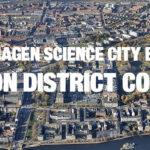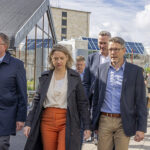Student start-up became supplier for Danish astronaut Andreas Mogensen
Astronauts need hard exercise to avoid losing bone and muscle during spaceflights. On his 2023/24 Hugin mission to the International Space Station ISS, Danish astronaut Andreas Mogensen tested an extraordinary motivator for his fitness regime. A Virtual Reality experience developed by the start-up company Syncsence and connected to the exercise equipment. Syncsence was launched by CEO Simon Bruntse while he was still a student at Copenhagen Science City-partner University of Copenhagen. By Jes Andersen.
From nursing home to space station
All Bruntse really wanted, was to help frail patients get better results from rehabilitation. With a fellow student he founded Syncsense to develop Virtual Reality experiences connected to motion sensors mounted on existing exercise equipment. When users exert themselves on the fitness equipment, a nature tour is piped into their Virtual Reality glasses. This boosts motivation. For patients and now for astronaut Andreas Mogensen during a six-month stay on ISS.
Astronauts and invalids face similar challenge
Syncsence is still based in the innovation centre UCPH Lighthouse at University of Copenhagen. Since its launch in 2018 the company has enjoyed access to office space, support for business development and courses in entrepreneurship in Copenhagen Science City. In 2023 Syncsense contacted Danish Aerospace Company, which produces exercise bikes for use in space. They wanted to connect Syncsense’s equipment to DAC’s bikes and send the package together with Andreas Mogensen into space. Mogensen arrived on the ISS in August 2023. Here he and the other astronauts live in surroundings that can be compared to hospitals or nursing homes.
It is equally important for astronauts on long space missions and for hospitalized patients to keep their bodies moving and be physically active every day. That our VR experiences have helped Andreas Mogensen and the ESA and NASA crew on the International Space Station gives us great satisfaction”: Simon Bruntse Andersen, CEO, SYNCSENSE.
Ground-breaking VR-experiments
In collaboration with NASA and ESA, and with the help of Andreas Mogensen, Danish Aerospace Company carried out ground-breaking experiments to explore whether virtual reality can improve the physical and mental health of astronauts on the space mission. They delivered the bikes. SYNCSENSE provided specially designed VR experiences for the trial. Mogensen provided enthusiasm.
The VR goggles combines with our bike on the space station so I can cycle 5 different routes in Denmark, for example a mountain bike ride in Silkeborg, a ride around the lakes in Copenhagen or a ride along the beach in Jutland. It feels like I’m out in nature instead of sitting on the bike here on the space station. It is especially motivating that the experiences are activated by the bike. When I cycle uphill, it feels like I need to work harder. The combination gives an incredibly realistic experience, where I get away from the space station and into nature. I love that.” Andreas Mogensen, Commander, Hugin mission, direct from the ISS
Blowing dust off underused equipment
The experiments aboard the space station provide highly visible evidence that VR transforms activities on boring exercise equipment into meaningful nature experiences. For the astronauts, it adds a welcome spice. For patients, the elderly and people with disabilities, Exercise becomes so motivating that underutilized equipment suddenly comes into play.
We are humbled to be part of something bigger, and we are excited that our VR technology can make a difference for the brave astronauts. Even so, our focus will continue to be here on Earth, where we use this technology to improve the physical and mental health of patients, the elderly and people with disabilities, who are unfortunately prevented from going on adventures”: Simon Bruntse Andersen, CEO at SYNCSENSE
Proud supporter
Mogensen’s mission ended in March 2024, and Syncsences’ cosmic results have been noticed in the University of Copenhagen innovation centre.
We are incredibly proud that one of “our” student start-ups has built a product that makes life better for astronauts. We are even more proud that the company’s founders keep their feet firmly on the ground and remember why they started the company in the first place. Namely to help the very weakest”:
Marius Sylvestersen, Chief Innovation Officer, UCPH Lighthouse, University of Copenhagen




